
Did you know that leftover tiles, broken ceramics, and different forms of glass can have a lasting impact on the environment?
Tiles, ceramics, and glass are not biodegradable – meaning they can remain in nature for hundreds of years. Even if taken to a landfill, they still take up valuable space and contribute to the need for more waste sites, which often requires using more land.
These materials are usually made from natural resources like clay, sand, and other minerals. Mining and processing these raw materials have serious environmental impacts. If we don’t recycle them, producing new ones will require more mining and energy use.
While tiles, ceramics, and glass are not harmful by themselves, they may contain paints or glazes that include heavy metals (like lead or cadmium), which can leak into the soil. Poorly handled construction waste can pollute both the land and water, and may even pose safety risks.
So how can we recycle them?
– Crushed construction waste can be used as base material for roads or other building projects.
– Broken tiles and ceramics are perfect for making mosaics or other decorative items.
– Glass is 100% recyclable – it can be melted and reshaped over and over again without losing quality.

Before throwing things out, ask around – you might find someone who can use them!
People doing home renovations, mosaic or glass artists, zero waste communities, or even home canners could all give these materials a second life.

Responsible waste management and creative reuse are key to reducing our environmental impact and building a more sustainable future.
Protecting the environment is very important to me too – that’s why I aim to reuse as many materials as I can, reduce waste during the creative process, and minimize household waste in general.
✨ Check out my available creations and see how old materials can turn into something beautiful.


